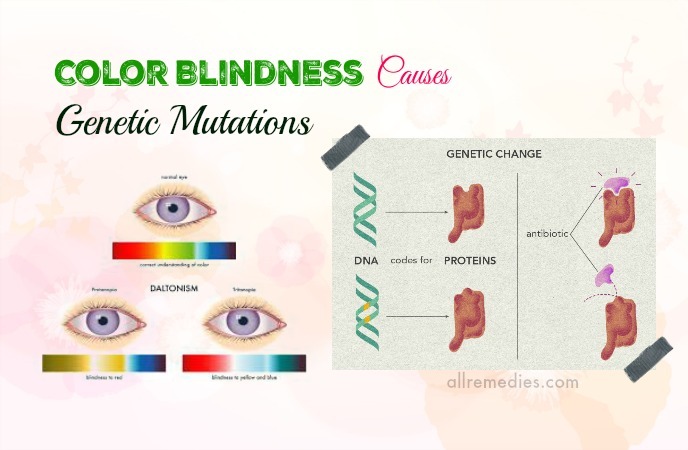
List of 13 Common Color Blindness Causes, Symptoms, And Effects
CONTENTS
Overview
Most people with color blindness [1] can see colors, but they have difficulty in distinguishing between some certain colors. Color blindness occurs in less than 1% of women and nearly 8% of men.
Get also: 35 Simple Natural Home Remedies for Dry Eyes Relief
Color Blindness And Causes, Symptoms Of This Color Vision Deficiency
In this article, we would like to show you some of the common color blindness causes, symptoms, and effects that you should know if you do not know why you, your children or other people around you have this color vision deficiency [2]. If you want to know more about facts and health conditions that can cause color blindness, read this entire article right now.
I. What Is Color Blindness?
Color blindness is reduced ability or even inability to see colors or to show the differences between 2 different colors under normal lighting. According to a study about color blindness facts [3], the term “color blindness” is not right because almost all “colorblind” people still see colors; however, their perception of color is limited. For people with color blindness, some certain colors are washed out and confused with other colors.
The common color blindness types include:
- Red-green color blindness
- Blue-yellow color blindness
- Complete color blindness
Nowadays, there is not a cure for color blindness. People with color blindness can use contact lenses and glasses with filters in order to help color deficiencies. Fortunately, most color-blind people’s vision is normal in all other aspects and difficulty in distinguishing between some colors does not affect their daily life too much. Problems can increase in choosing and preparing food, sport, gardening, and choosing items of clothing.
AllRemedies Partner Solutions

Keep Asking Questions Until You Get The Answer You Need!
The Medical Experts are all here to answer your questions online or with a phone call.
See also: 26 Tips Natural Home Remedies for Red Eyes Relief
II. Symptoms Of Color Blindness
The color blindness symptoms are often noticed by parents when their children are learning colors. In some cases, these symptoms are so slight, and not many people notice that they have a color deficiency. The symptoms can vary from mild to severe.
Some common symptoms of color blindness that you can observe are:
- Inability to notice shades of the same color
- Having difficulty in distinguishing between different colors
- Involuntary eye movement
- Light sensitivity
If a child has color blindness, his parents can notice the following clues:
- Using the wrong colors when coloring
- Having low attention when coloring
- Smelling food before eating
- Headaches when looking at the combination of colors; for example, a green item on a red background
- Excellent night vision and sense of smell
- Sensitivity to bright lights
If you notice that your children experience any color blindness symptoms above, talk to your child’s doctor as soon as possible.
Read also: 27 at Home Remedies for Pink Eye in Adults
III. Causes Of Color Blindness
There are some common color blindness causes, and today, we will reveal some of these common causes that you should pay attention to:
1. Glaucoma

This is the first one in the list of color blindness causes that we want to mention in this article and want all of our readers to know for good. For people who are suffering from glaucoma [4], their internal eye pressure or the intraocular pressure may be too high. This pressure can damage their optic nerves that are responsible for carrying signals from their eyes to their brain. Therefore, your ability to see and distinguish colors may be reduced. According to a study, the inability to distinguish yellow and blue of those with glaucoma has been noticed since the 18th century.
Glaucoma is caused by abnormally high pressure inside the eye. According to research about high eye pressure and glaucoma [5], the increased pressure inside the eye can damage your optic nerve tissues, resulting in vision loss or even blindness. The most common glaucoma type is primary open-angle glaucoma. There is no obvious sign or symptom of glaucoma, but gradual vision loss. Therefore, it is very important for you to make comprehensive eye exams, so your eye specialist can detect any changes in your vision. You may have glaucoma if you experience some following symptoms:
- Nausea and vomiting
- Severe eye pain
- Redness in the eye
- Seeing colored rings around lights
- Sudden vision disturbances
- Sudden blurred vision
The eye’s back continuously creates a clear fluid. When this fluid is created, it will fill the front part of the eye and then it will leave the eye through channels in the iris and cornea. In case these channels are partially obstructed or blocked, the natural pressure inside your eye may increase, causing the optic nerves to be damaged. As a result, you may start losing sight.
The causes of increased pressure in your eye are not known. But, some of these factors may play a role:
- Blocked drainage in the eye
- Dilating eye drops
- medications, such as corticosteroids
- Reduced blood flow to the optic nerves
- High blood pressure
Find also: 58 Best Natural Home Remedies for High Blood Pressure Control
26 Natural Home Remedies for Vomiting in Adults & Children
2. Optic Neuritis
When it comes to common color blindness causes, optic neuritis is an eye problem you should not look down [6]. The optic nerves carry signals from the eye to the brain, and optic neuritis occurs when your optic nerves get inflamed. It can occur suddenly from a nerve disease or an infection. The inflammation causing temporary vision loss often occurs in only one eye. In some cases, people with optic neuritis experience pain. When the inflammation disappears, their vision will go back. Optic neuritis does not need treatment, and it can heal naturally. Some medications can help boost up the recovery.
You are at higher risks of developing optic neuritis if:
- You are a female, from 18 to 45 years old
- You have multiple sclerosis
- You live in New Zealand, Northern United States, etc. where has a high latitude.
The causes of optic neuritis are not known, and most cases are idiopathic. Some common causes of optic neuritis are:
- Multiple sclerosis
- Neuromyelitis optica [7]
- Schilder’s disease
- Measles
- Mumps
- Tuberculosis
- Viral encephalitis
- Lyme disease
- Meningitis
- Sinusitis
- Shingles
- Sarcoidosis
- Post-vaccination reaction
- Guillain-Barre syndrome
- Certain chemicals or drugs
Get also: 35 Best Natural Home Remedies for Sinusitis Relief
21 Home Remedies For Chickenpox Spots & Scars
3. Macular Degeneration
Macular degeneration is known as a common eye issue that leads to central vision loss. Macular degeneration may not cause total blindness as it does not affect the peripheral vision. The cause of this eye disorder is the deterioration of the macula. According to research about types of macular degeneration [8], there are two types of macular degeneration, including wet macular degeneration and dry macular degeneration.
Dry macular degeneration is found to be the most common type of this eye disorder. It occurs because of small yellow deposits developing under the macula, causing retinal damage as well as vision loss. Meanwhile, wet macular degeneration occurs when blood vessels abnormally develop under the macula and retina. If you have wet macular degeneration, you may notice a dark spot in your vision’s center due to leaking fluid or blood vessels bleeding. Wet and dry macular may not affect peripheral vision. This eye disorder can prevent you from seeing objects that are in front of you, but it will not cause complete blindness
Macular degeneration is a progressive eye condition, and it will become worse over time. Maybe, you do not know that you have this eye disorder in its early stages. Macular degeneration is on the list of color blindness causes, and some common symptoms of macular degeneration are:
- Distortion of straight lines in the vision
- Reduced central vision
- Needing brighter lighting
- Difficulty in adapting to low lights
- Difficulty in recognizing faces
- Blurriness
- A blurry spot in the vision
- Hazy vision
Learn more: 9 Health Benefits Of Eyebright Herb
4. Diabetic Retinopathy
It is known as a serious eye disorder that can result in decreased eyesight and blindness. Of course, it is also known as one of the common color blindness causes that you should not ignore. It occurs in those with type 1 or 2 diabetes. Annual eye exams are important tools to prevent this eye disorder. Diabetic retinopathy occurs due to damage to the retina’s blood vessels in people with diabetes. While you have only mild vision problems, losing your sight is what you can suffer from.
Non-proliferative diabetic retinopathy is a common type of diabetic retinopathy. During its early stages, damaged blood vessels often leak fluid and blood into the eye. Sometimes, the center of the macula or retina begins to swell. Three stages of non-proliferative diabetic retinopathy are mild, moderate, and severe, and it may progress to the fourth stage called proliferative diabetic retinopathy. According to a study, proliferative diabetic retinopathy is the last stage of diabetic retinopathy in which some new blood vessels start growing within the retina.
It is not common to notice symptoms during its early stages. The signs and symptoms of diabetic retinopathy do not occur until the damage appears inside your eye. In order to prevent damage, try to keep the blood sugar levels under control and make regular eye exams. When the signs and symptoms of diabetic retinopathy appear, they are commonly noticed in both of your eyes, and they include:
- Seeing dark spots
- Difficulty in seeing at night
- Vision loss
- Blurred vision
- Difficulty in distinguishing colors
See more: 37 Best Natural Home Remedies for Diabetes Mellitus
24 Natural Home Remedies For Low Blood Sugar Level Treatment
5. Genetic Mutations

Almost all of the people who have color blindness inherited this eye condition from their parents and this condition is present at birth. The human eye has 3 cone cell types with green, red, or blue light. These cones are present in the macula connecting to the main retina’s part. For people who have inherited color blindness, one of their cone cells does not work properly, and then they will not be able to see one of the basic colors or even see different tones of that specific color.
According to research about an overview of color blindness [9], it has shown that mutations causing color blindness are from 19 different chromosomes and a few different genes. The most common is gene mutation on the X chromosome. Men have only one X chromosome while women have 2 X chromosome. If one X chromosome in women is defective, the other one will protect them from having color blindness. A woman who has a defective gene, her sons will have a 50% risk of being color blind, and her daughters will have a 50% risk of being a carrier. Inherited color blindness symptoms can appear from birth, or appear during childhood as well as early adulthood. Inherited color blindness can be developing and can result in full blindness.
In fact, this is also on the list of color blindness causes that you should know and then follow the proper precautions for good.
Find also: Top 28 Best Natural Food Sources of Vitamin B6 on the Planet
6. Cataract
A cataract is a cloudy area that appears in the lens of your eye. It begins when proteins in the eye create clumps that may prevent the lens from transferring clear images to the retina. The retina converts the light coming through the lens into signals and sends the signals to your optic nerve and your brain. This eye problem develops slowly and can affect your vision. Finally, you may have cataracts in both of your eyes. Cataracts are commonly found in older people.
There are some different types of cataracts, and they include:
- Nuclear cataracts occur in the middle of your lens, and they may cause the center to become brown or yellow.
- Posterior capsular cataracts affect the back of your lens.
- Cortical cataracts occur around the nucleus’s edges.
- Congenital cataracts are present at birth or appear during the first year
- Secondary cataracts are caused because of diseases such as glaucoma and diabetes or medications.
- Traumatic cataracts occur after an eye injury, and it can take a few years to happen.
- Radiation cataracts can occur after an individual undergoes radiation treatment for some types of cancer.
There are a few underlying causes of cataracts, and they include:
- An overproduction of oxidants
- Ultraviolet radiation
- Smoking
- The use of steroids as well as other medications
- Some certain diseases
- Radiation therapy
- Trauma
Cataract is known as one of the common color blindness causes, and some common symptoms of cataract are:
- Blurry vision
- Difficulty in seeing at night
- Increased sensitivity to glare
- Seeing colors as faded
- Halos surrounding lights
- The need for changes in prescription glasses
- Double vision in your affected eye
Get also: 26 Tips How To Use Clove Oil For Toothache, Bad Breath, PE, Cancer
7. The Long-Term Use Of Medication
When you are looking color blindness causes, you should not forget the long-term use of medication. Color blindness can be a side effect that you may experience after using a medication such as digoxin, chloroquine, ethambutol, phenytoin, hydroxychloroquine, and sildenafil. Certain antibiotics and medications for high blood pressure can also cause color vision deficiency. This eye condition can go away on its own after you stop taking your medication.
Find also: 29 Best Natural Home Remedies for Low Blood Pressure Fast
8. Trauma
Accidents and other traumas can result in swelling in the visual processing part of the brain called the occipital lobe. In fact, trauma has been reported to be the leading cause of color blindness by a lot of people in the world; therefore, it is known as one of the color blindness causes that you should know.
Check also: 16 Natural Remedies How To Get Rid Of A Black Eye & Swelling Fast
9. UV Damage
Another one in the list of color blindness causes that you should know is UV damage. The over-exposure to UV rays may result in degeneration of the retina. And it is also the leading cause of blindness cases. However, the eye damage often presents during the mature years.
Learn also: 25 Evidence-Based Home Remedies For Styes Under & Upper Eyelid
10. Shaken Baby Syndrome
Other common color blindness causes that you should know must include shaken baby syndrome. This syndrome can result in retina and brain damage. As a result, it can cause color vision deficiency in both infants and children. This eye damage is permanent, so that these effects will be carried on into the adult life.
11. Aging

The researchers found that color vision abnormalities were associated with different age groups. In the study, about 40% of the participants had failed on one of the two tests of color vision and about 20% failed both tests. According to the study, the failure rate was higher in older age groups. About 80% of the abnormalities involved in the confusion of the lighter tones of yellow versus green, blue versus purple and yellow-green. The “blue-yellow” confusion is different from the “red-green” confusion that is observed in those with inherited color blindness.
Actually, aging is also on the list of color blindness that you should know and then follow some natural treatments to improve your eye health as you age.
Keep reading: 31 Health And Beauty Benefits Of Ginkgo Biloba
12. Retinoblastoma
Retinoblastoma [10] is a rare eye cancer type that often develops in early childhood. This cancer type occurs in the retina, the light-sensitive tissue at the eye’s back that is responsible for detecting light and color.
Children with retinoblastoma often have an affected eye, and in some cases, they develop this type of cancer in both eyes. The most common symptom of retinoblastoma is a visible whiteness called “cat's eye reflex”, which is particularly observed in dim light or photographs with a flash. Besides, other common symptoms of retinoblastoma are crossed eyes, a change in the color of the eye’s iris, soreness, redness, or swelling of the eyelids, and poor vision.
Retinoblastoma can be treated if this type of cancer is diagnosed early. Nonetheless, if this cancer is not treated accordingly, it can spread to other body’s parts and can be life-threatening.
Check also: 21 Home Remedies How to Grow Thick Eyebrows & Eyelashes
13. Other Causes Of Color Blindness
Apart from the common color blindness causes as we mentioned above, there are other factors that can lead to this color vision deficiency. They include:
- Exposure to some harmful chemicals such as styrene and carbon disulfide
- Injury to the eye
- Cone Dystrophy
- Achromatopsia
- Cone-rod Dystrophy
- Blue cone monochromatism
- Retinitis pigmentosa
- Leber’s congenital amaurosis
- Alzheimer’s disease
- Leukemia
- Vitamin A deficiency
- Chronic alcoholism
- Liver disease
- Parkinson’s Disease
- Sickle cell anemia
Read also: 30 Best Natural Treatments For Vascular Dementia
IV. How To Live With Color Blindness
There is no treatment for color blindness, so you need to learn ways to live with the color vision deficiency. If you or your children have color blindness, you need to take the following steps:
- If your children have inherited color blindness, tell their school so that their learning materials can be changed accordingly
- Teach your children the colors of common objects.
- Ask your family members or friends for help. For instance, they can help you check if your foods are safe to eat and choose matching clothes
- Install good-quality lighting in your working environment and house to help in distinguishing colors
- Memorize the order of objects with colors such as traffic lights.
- Change the settings of computers as well as other electronic devices in order to make these devices easier to use
- Use a few mobile phone apps designed for those with a poor color vision to help identify colors
- Try using specially tinted lenses to help in distinguishing between colors
See also: List Of 17 Common Types Of Dementia And Early Symptoms
34 Sure Short Tips On How To Relieve Stress In Workplace And School
Conclusion
After discovering the list of common color blindness causes, symptoms, and effects, we hope that you and our other readers of AllRemedies can learn something from that. Especially, this article is helpful for parents who have children with color blindness. Keep in mind that detecting and following the proper precautions early can help improve this eye disorder. So, if you think that this list is helpful and can help other people around you, feel free to share this list with them as soon as possible. Also, if you have any ideas about eye health or know other color blindness causes, symptoms, and effects apart from those as we mentioned above, remember to share them with other readers below.

GET FREE ACCESS!
Lorem Ipsum has been the industry's standard dummy text ever since the 1500s, when an unknown printer took a galley of type and scrambled it to make a type specimen book. It has survived not only five centuries
Also on
- 5 Tips How to Use Raw Apple Cider Vinegar for Diarrhea & Vomiting
- 10 Ways How To Use Oregano Oil For Yeast Infection On Skin & In Dogs
- Top 13 Amazing Uses & DIY Recipes of Vitamin E Oil for Face Skin
- 15 Tips on How to Stop Dizziness Fast from Flu and Allergies
- 17 Trusted Home Remedies For Cracked Hands
- Top 9 Miraculous Himalayan Pink Salt Uses and Benefits for Health
- 8 Must-Know Health Benefits of Sorghum Grain, Flour, Recipes, Meal
- 25 Simple Natural Home Remedies for Dry Eyes Relief
- 29 Proven Home Remedies for Dry Cough: Causes, Prevention, Cure
- What are the Causes of Leg Cramps & Pain and Treatments
JOIN THE CONVERSATION










